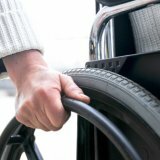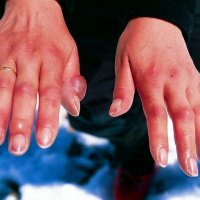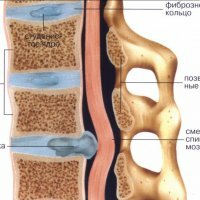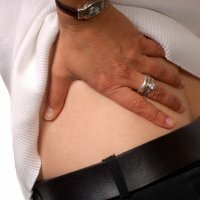Violation of the functions of the musculoskeletal system

An old age disability is often caused by specific medical problems. The ability of a patient to move independently is quite often restored with adequate treatment. The problem, which is now topical for everyone, is a violation of the functions of the musculoskeletal system.
This problem, which occurs in people in old age, is caused by three groups of diseases:
- strokes;
- diseases of the joints, this group includes degenerative diseases of the joints;
- diseases of the feet.
Strokes.
Muscle spasms, paralysis and flexion contractures of the joints, which are accompanied by a significant deterioration of the musculo-articular feeling and gait disturbance, and weakness are a consequence of musculoskeletal disorders and stroke. All this leads to the disability of patients who are able to move independently, and in more severe cases to a restriction of mobility and complete immobility due to an increase in the likelihood of falls.
To increase the independence of patients and minimize the consequences of disability, active rehabilitation and appropriate methods of physiotherapy are necessary.
Loss of mobility and disability can be caused by various diseases. Although a complete cure for these diseases is not possible, however, they are amenable to therapeutic treatment. There are measures that can, if not prevent, then at least delay the loss of the ability to independently move and take care of themselves.
For this there are certain recommendations:
- swimming and walking are especially useful for improving the function of muscles and joints;
- daily physical exercises help to constantly maintain themselves in the form of impaired functions of the musculoskeletal system;
- it is necessary to immediately seek medical help if there are symptoms of osteoarthritis and rheumatoid arthritis, disorders of the musculoskeletal system and symptoms of osteoporosis;
- course of drug therapy( if necessary) will help if not to stop, then delay the progression of the disease, but before that you need to undergo an examination and consult a rheumatologist;
- calcium and vitamin D should be in sufficient quantities to be present in the diet;
- always keep your feet in a healthy state;
- exclude the possibility of falling at home.
Diseases of the joints.
There are many diseases of the musculoskeletal system and disorders of the musculoskeletal system, leading to the loss of the possibility of independent movement in old age. Especially often there are such diseases as osteoarthritis and rheumatoid arthritis, as well as osteoporosis. All these diseases are usually controlled by medication, smoothing complications and reducing the likelihood of a possible disability. One of the most common diseases of the joints are gout and osteoarthritis, as well as rheumatoid arthritis. These diseases cause swelling and changes in small joints of the ankle and toes, which causes their stiffness and soreness.
These diseases can cause difficulty walking, as well as permanent foot disturbance. But, fortunately, these diseases succumb, at early stages, to the treatment of drug therapy.
In general, rheumatoid arthritis and osteoarthritis related to degenerative diseases are affected by the ankle, knee and hip joints, the deformation of which can lead to disability. Prosthetics is the most effective way of restoring the functions of the knee and hip joints. A complete replacement of the hip joint can return the patient to a normal lifestyle.
Osteoporosis is a common disease. This disease is characterized by a decrease in bone density, which often leads to increased fragility of the bones. The disease often leads to the inability to move due to falls. In general, the disease is common in about thirty to forty percent of women. In connection with the absence of hormonal changes in men, which are associated with menopause and a much larger bone mass, the prevalence of this disease is much lower than that of women. As a rule, fractures occur in the bones of the spine, hips and brushes. The fracture of the femur can lead to the greatest complications and even to death. This disease is characterized by a rapidly progressive nature. If the patient suffered a fracture in the presence of osteoporosis, then there is a fairly high level of repeated fracture during the year.
Disease of the feet.
Older people are not uncommon for a disease such as "bumps" on the outer surfaces of the thumbs, as well as "hammer-shaped fingers" and ingrown nails. These diseases, although not severe, are very painful and, therefore, often make walking difficult. Only specialized medical care relieves such pain.
Risk factors for musculoskeletal disorders.
The degree of risk can be determined from the bone mineral density( BMD).
Risk is characterized by the following factors:
- obesity;
- lack of calcium in food;
- reception of glucocorticoids;
- the presence of osteopathic diseases in the family.
Treatment.
Diseases are treated with calcium and vitamin E. For women, hormone replacement therapy with estrogen during postmenopause is additionally prescribed. No less effective antiresorptive drugs. The most common disease of joint inflammation is rheumatoid arthritis. For one hundred thousand people, the disease is observed in 5,600 cases, and mostly, at the age of after sixty years. In women, this disease is observed in 3 times more often than in men, although with age this difference is reduced. The disease is usually chronic and often results in a disability. Symptoms of the disease may be mild, but sometimes there may be a violation of the functions of the joints with severe deformation. In severe disease, ninety percent of patients suffering from rheumatoid arthritis, within 20 years of continuation of the disease may become disabled. This disease shortens life by ten years for women and by four years for men. Diagnosis consists in radiographic examination and blood analysis for the presence of the disease, although even a negative result does not exclude the disease.



